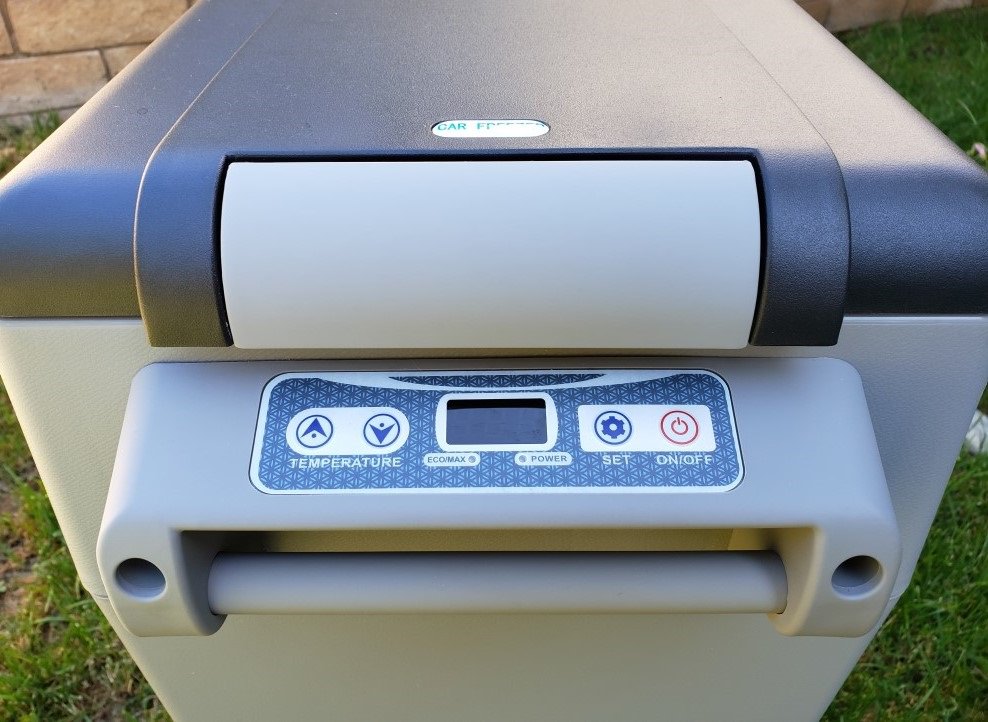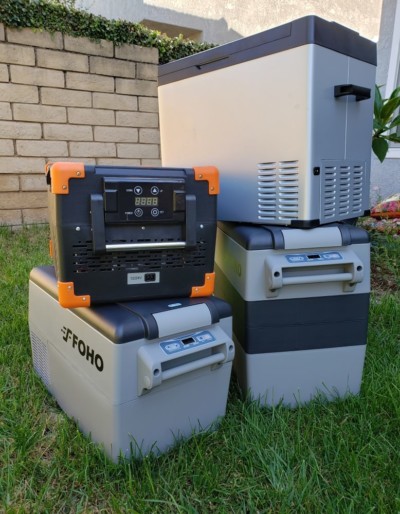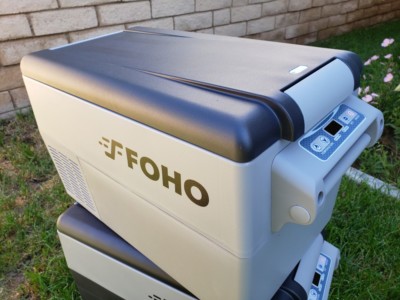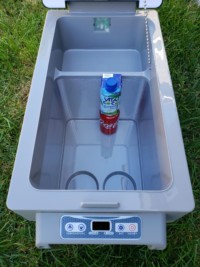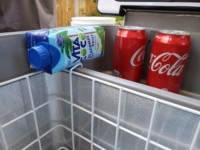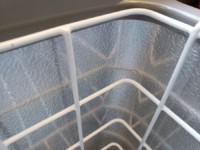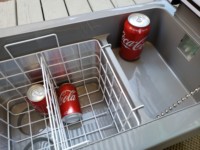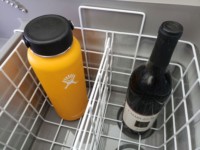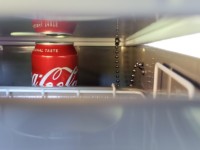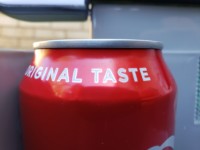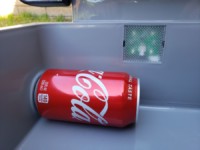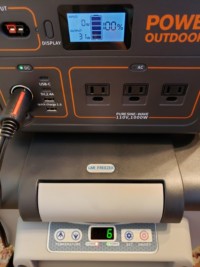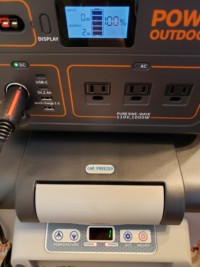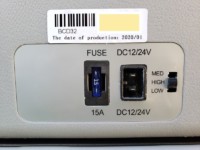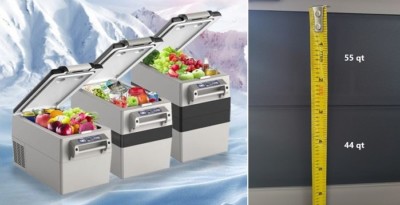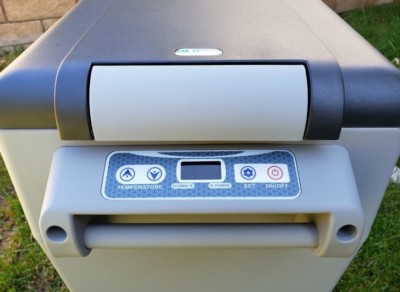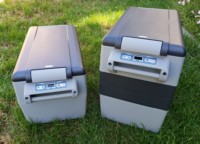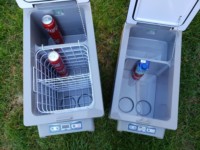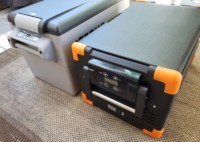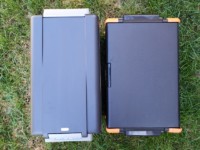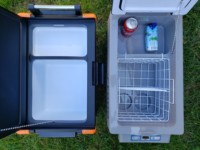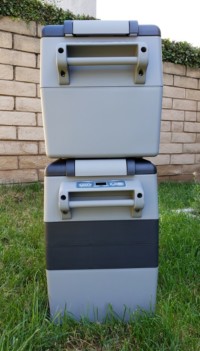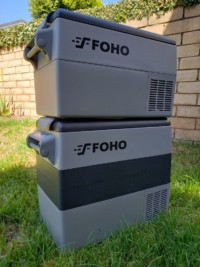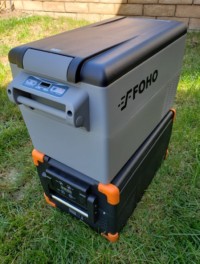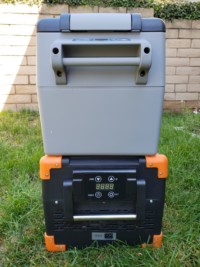Foho 34qt Car Freezer/Fridge (BCD-32)
Pros
- Low energy usage
- Fast cooling/Consistent temperatures
- Freezer and chiller sections
- Good capacity for small trips
- AC power and 12V car plug options
Cons
- Heavy, especially when full
- No wheels or wheel kit available
- No drain hole for melted/spilled liquids
- May be too small for some needs
- Priced nearly the same as 55qt model
Contents
In Love With Foho
Nearly 2.5 months ago, I purchased our first car freezer, the Foho BCD-52 (55 qt), for traveling, outdoor, and emergency use. It had served us very well during a whole-day power outage working from home and had since been used as extra freezer space. Occasionally, we took it to parks with our trusty Jackery Explorer 1000 battery power station to keep fruit and drinks cool under the hot summer days. My wife was completely against having one at first but had since found it very useful. During the past month, a former coworker and a friend each asked for an opinion of their car freezers (or rather, I convinced them to let me borrow and review theirs for this site), and that gave me a unique opportunity to see how different brands, form factors, and sizes compared.
Rockpals RP-25L (26 qt)
First, there was the 26 qt Rockpals RP-25L: a beautiful-looking, two-compartment car freezer that felt too small for our use and was smeared by a nasty bug whereby changing the unit display from Celsius to Fahrenheit introduced all sorts of problems. The unit behaved unpredictably and even refused to turn on. It worked wonderfully when operating in its default Celsius setting. I jokingly told my former coworker that his Rockpals unit had beauty but lacked the brains until the company figured out a fix. Meanwhile, I advised him to leave it on Celsius.
Domende HC-5o (54 qt)
Second, my friend surprised her husband with the 54 qt Domende HC-50: a one-compartment unit that could only cool the entire interior under just one temperature. In other words, it could only be used as a refrigerator OR freezer, but not both like the Rockpals RP-25L or Foho BCD-52. The lack of a divider between two compartments, however, gave it a unique advantage: it could accommodate larger and longer items and maximize its storage space. I thoroughly enjoyed its Bluetooth app functionality that allowed remote control via a mobile device.
Foho BCD-52 (55 qt)
When I returned the Domende to my friend, I came to realize that although the Foho BCD-52 was initially considered somewhat ugly, it became an even stronger favorite among the three freezers. It was by far better built AND more quiet than the other two, and came with a wire basket for the larger compartment to more conveniently take items in and out of. As some people say, your first love can never be matched by anyone else. Perhaps that applied to car freezers, too? There were pros and cons for each of the three units, but Foho consistently gave us the most appreciation for its design.
The Foho consistently gave us the most appreciation for its design, performance, durability, silence, and reliability.
There is one glaring problem with the 55 qt Foho, however: it is LARGE and relatively HEAVY especially when full. My eyes wandered towards the good-looking Rockpals, but she was too small in capacity. I did like my former coworker’s idea of using that size for grocery shopping and running errands — it gave him time to relax and not stress over having to rush home to put groceries away. I also liked how comparatively light and nimble it was — something my bad back would be thankful for. So, my plan went into action to try to convince the wife to purchase the 34 qt Foho BCD-32. To much surprise, she was fully on board without a fight! She had felt the 55 qt was too large for traveling, too! And so here we are: a review for the smallest of the three Foho models.
The “Foho” brand is derived from “For Home”
Review: Foho BCD-32 (34 qt)
This review is based on using the car freezer at home for 6 continuous days with temperature set to -4F (-20C). It was powered by the Jackery Explorer 1000 (and 2 Jackery SolarSaga 100W solar panels) and the Goal Zero Yeti 500x for a few hours for testing and reviewing purposes. Power usage by the Foho primarily depends on the ambient temperature that surrounds it. For 30 hours, the BCD-32 was also operated as a refrigeration unit with temperature set to 40F.
What’s Good? What’s Bad?
Pros
- Capacity is JUST right for a sedan or smaller trips (can hold up to 28x 12oz water bottles or soda cans)
- Two sections: Freezer and Chiller
- Chiller section can BARELY fit an upright soda can, but I strongly recommend to have them sideways instead
- Freezer section can accommodate a standing wine bottle and Hydro Flask 40 oz
- About 40% smaller than the 55 qt BCD-52 model
- Size has been perfect for our family of four (4) for occasional camping/road trips and perfect for grocery shopping
- Two sections: Freezer and Chiller
- VERY portable and surprisingly light for its class
- Much, much lighter than the 55 qt model
- Goes from room temperature to freezing VERY quickly (Fast-Cool feature)
- After about 30 minutes, freezer section went from 72F to 23F, and the chiller was at 39F
- After 1 hour, freezer was -1F, and chiller 33F
- Note: Refrigerant R134a with mass charge of 30g (+/- 0.5g) is used
- According to a thermal engineering website, R134a is a “non-flammable gas used primarily as a ‘high-temperature’ refrigerant for U.S. refrigeration and [car ACs]… [It] is non-toxic, non-flammable and non-corrosive.”
- 44 qt (BCD-42) and 55 qt models (BCD-52) use a mass charge of 40g
- Ice is no longer needed (and no more watery messes!)
- Adjustable temperature: -4F to 50F (-20C to 10C)
- Allows use as either a fridge OR freezer (with a fridge section — Warning: COULD freeze items in there overnight if the temperature is set too cold)
- 2 Energy modes: Max and Eco
- Max is useful when surrounding temperature is 86F+ (30C) and Fast-Cool is needed. Runs compressor at a higher speed
- Eco mode, although using less energy, can ruin the compressor in the long run
- “ECO/MAX” LED: Max = Red. Eco = Green
- Temperature was roughly consistent during 6 days of continuous use. It was set at -4F, and spot checking throughout the days resulted in:
- Larger compartment: Between -5F and 4F (in Max mode)
- Roughly -2F to 8F difference from set temperature is most likely the result of “E3” set to a default of 3C/5.4F (see PROGRAMMING section)
- When temp was set to 40F, display varied between 37F and 44F
- Eco mode can cause larger fluctuations
- Fast-Cool feature works in both modes
- Roughly -2F to 8F difference from set temperature is most likely the result of “E3” set to a default of 3C/5.4F (see PROGRAMMING section)
- Chiller section: Around 30F, eventually freezing anything left there
- Appears to have good insulation
- Understanding how a standard refrigerator works will educate you how this car freezer similarly operates. See the TIPS section for more details
- Larger compartment: Between -5F and 4F (in Max mode)
- Two (2) Power options
- 12V or 24V car adapter (draws about 3-5A on 12V)
- 100-240V AC wall plug, outputting 14.5V at 6.0A (or about 87W)
- Cables for both included. Car cable is generously long at 11.5′
- Low energy usage. (See TIPS section for calculating how long the car freezer could be used for on a battery power station)
- Foho only uses power to reach or maintain set temperature (“Power” LED = Green). Once there, it goes idle (“Power” LED = Red)
- The colder the set temperature, the more energy will be used
- 53W with AC port of the Jackery Explorer 1000 (7W of that is used by Jackery’s inverter)
- Product description states 55W, but the Jackery reported up to 46W draw
- 31W with 12V DC car port on the Jackery
- 1W – 3W on idle (Green “Power” LED)
- Foho only uses power to reach or maintain set temperature (“Power” LED = Green). Once there, it goes idle (“Power” LED = Red)
- Three (3) levels of Battery Protection to prevent the car battery from running down
- Auto resume: When power supply is cut off and later restored, appliance continues operation
- Quiet operation (up to 40 dB, according to Foho)
- Built-in LED over chiller section to help see in the dark
- Usable during off-roading
- Works at up to 30 degree angle tilt
- Anti-shake design keeps compressor protected
- Removable wire basket to easily load/unload content from freezer section
- Removable divider for additional organization
- Sturdy carry handles on both ends
- Can secure Foho to car with straps, making it ideal for off-roading
- Lid opens from the front. Some may prefer a side opening
- Less vertical clearance is needed to fully open a side-mounted lid
- Can be used while the car is turned off, if its car port has a bypass to work directly off the battery
- Many SUVs, trucks, and minivans today have such output at the back. Refer to the car’s owner manual
- Overload protection with a replaceable 15A fuse
Cons
- Like other car freezers in this Foho’s price range, requires manual defrosting
- To defrost and remove excess ice, power off the unit and wipe dry, then power back on
- Do not allow a large amount of frost to build up on the inside of the walls as that will make cooling less efficient
- I was not immediately able to find any portable car freezers that have an automatic, self-defrost cycle that “cleans” the freezer from accumulating too much frost
- To defrost and remove excess ice, power off the unit and wipe dry, then power back on
- No drain hole at the bottom to let excess or spilled liquid out
- You will have to use a towel to pick up leftover liquid, especially after defrosting
- Chiller section is a few millimeters (or around 0.1″ – 0.2″) too short
- Soda can cannot stand upright (actually, you can make it work by slightly forcing the lid closed, but I strongly advise against that)
- At around 33 lbs, could be heavy for some, especially if the inside is completely full
- No wheels to transport with
- No wheel kit available. Use a two-wheel cart to transport as needed
- Do NOT mess up your back as that will haunt you for the rest of your life!
- May be too small for longer trips or larger families
- Where power cord is plugged in at the back, the plastic flexes a bit
- Makes me worry about whether it would crack over time with too much force. So, plug in carefully!
- Not waterproof. Keep it out of the rain
- No built-in cup holder on the lid
- Cannot be directly powered by Solar panels via MC4 or Anderson interfaces to make it a solar-powered freezer
- GoSun has a cooler with a built-in solar panel
Model Sizes
There are three, available models: BCD-52, BCD-42, BCD-32 (Quarts: 55, 44, 34. Liters: 52, 42, 32). The length and width are the same with only the height being different. Roughly, each smaller model is 3″ shorter, the equivalent of each of the dark gray bars in the middle (below the “Foho” logo).
Tips
- When you receive your car freezer, do NOT plug it in until it has stood upright for at least 10 hours to allow the refrigerant to settle
- Internal temperature is displayed on the LCD at power-on and updates periodically
- Power off/on by holding the “ON/OFF” button for a few seconds
- There is no built-in battery
- Requires a power station, 12V/24V DC/car port, 120V/220V AC, or solar panel(s) capable of providing at least 60W of sustained power
- Compressor is made by Wancool ZH25G
Battery Voltage Protection
There are 3 levels of protection: High, Medium (Default), and Low. It is configured through a physical switch at the back of the unit.
- The car freezer will operate until the battery reaches a specific voltage level. Not setting the appropriate level could potentially leave you stranded with a car that will not start
- Compressor stops when 12V battery reaches 10.2V (Low), 10.7V (Medium), 11.7V (High)
- Resumes at 11.2V (Low), 11.7V (Medium), 12.7V (High)
- When connected to a battery power station: Use Medium or Low
- When connected to a car: Use High or Medium
Settings
“Set” button cycles through Fahrenheit/Celsius display and Max/Eco modes
- Eco uses less power (runs compressor at lower speed) than Max to minimize draw on any connected battery, but can ruin the compressor in the long run
- “ECO/MAX” LED on control unit: Max = Red. Eco = Green
Programming
To enter programming mode: Hold the “Set” button for 6 seconds. Cycle through the options by pushing “Set”, and change values up or down with the respective “Up” or “Down” buttons. To accept the setting, leave the screen blinking until it stops (approximately 6 seconds).
Here are the various options that can be programmed. They should not be modified as they could cause your freezer to fail or be damaged.
PROGRAM AT YOUR OWN RISK!
- E1: Lowest temperature that freezer can be set to cool down to. -40C/-40F to Target temp. Default: -20C (-4F)
- Caution: setting the value too low may damage the compressor
- E2: Highest temperature that freezer is allowed to reach. Target temp to 40C/104F. Default: 10C (50F)
- E3*: Difference from target temperature before powering up compressor again. 1C/1.8F to 10C/18F. Default: 3C (5.4F)
- Compressor should stop at target temperature (ie. 4C), and start again when internal temperature is E3’s value above it (ie. 4C + 3C = 7C)
- E4: Time delay protection. 0-10 mins. Default: 3 min
- To protect the compressor, it will wait that amount of time after being idle/powered off before turning on again
- F1*: Do not modify. Temperature compensation (for temp set to above -6C/21.2F). -10C/-18F to 10C/18F. Default: 2C (3.6F)
- Displayed temperature = Detected temperature + Temperature compensation
- Used to match Displayed temperature to what is actually Detected inside the unit
- Displayed temperature = Detected temperature + Temperature compensation
- F2*: Do not modify. Temperature compensation (for temp set to between -12C/10.4F and -6C/21.2F). -10C/-18F to 10C/18F. Default: 3C (5.4F)
- F3*: Do not modify. Temperature compensation (for temp set to below -12C/10.4F). -10C/-18F to 10C/18F. Default: 4C (7.2F)
* Each difference of 1C is 1.8F
Temperature Compensation
If you find the temperature displayed on the control panel is different than what is actually inside, the discrepancy can result in content overcooling or being too warm. For instance, if you meant to keep fruit cool at a set 40F, but the true temp inside is 32F, you will unintentionally have FROZEN fruit. Or, if you wanted to keep meats frozen at 29F, but the true temp inside is 36F, you may find the content having melted.
The displayed temperature should be roughly the same (by about 5.4F by default) as the actual one inside because the compressor will ONLY stop cooling when the display (not the storage’s true temp) matches the set degrees.
If you find the temperature displayed on the control panel is different than what is actually inside, the discrepancy can result in content overcooling or being too warm.
To correct the discrepancy between the set/displayed temperature and what the internal storage really is, place two, reliable thermometers inside and perform tests with temps set to 0C, -9C, and -20C (one for each of the F1 – F3 ranges). I found the calibration easier to start with the warmer values first. If, for example, the display is 8C, 4C, and 1C higher (for each range) than what is inside, set the temperature compensations to: F1 = -8C, F2 = -4C, and F3 = -1C.
Runtime with Battery Power Stations
- To calculate how long the car freezer could be used for with a battery power station depends on the battery’s capacity (Wh) and how much power (W) the Foho draws
- Examples are with a Jackery Explorer 1000 (1002 Wh). Halve the time when used with a Goal Zero Yeti 500x (500Wh)
- Plugged into AC port: 1002 Wh x 0.85 / Device Wattage
- As short as 16 hours (1002 Wh x 0.85 / 53W)
- Informal testing found an estimated use of 500-600 Wh/day as a fridge. It was idle much of the time
- About 10-15% of power is lost during conversion from DC (battery) to AC, which is normal for all power stations
- As short as 16 hours (1002 Wh x 0.85 / 53W)
- Plugged into DC port: 1002 Wh / Device Wattage
- As short as 32 hours (1002 Wh / 31W)
- In reality, because the unit stays IDLE most of the time, it should last a LOT longer than the hours listed above
- Plugged into AC port: 1002 Wh x 0.85 / Device Wattage
Foho only uses power to reach or maintain the set temperature. Once there, it goes idle to minimize power draw. As such, the Foho could last a lot longer than the times listed above
Cooling Efficiency
- Foho only uses power to reach or maintain the set temperature (“Power” LED = Green). Once there, it goes idle (“Power” LED = Red)
- Time can be shorter or much longer, depending on how often the Foho’s compressor needs to be activated to reach or maintain target temperature
- The colder the set temperature and/or the warmer the ambient (surrounding) heat, the more energy will be used
- Keep in a cool location and out of direct sunlight for best efficiency
- Consider putting the Foho in an insulated bag for better cooling
- Ensure adequate air flow (4″+) on all sides of the Foho, especially the back
- The more frozen/cold items are inside, the longer they can stay cool/frozen. Avoid opening the lid too often or for too long
Maintenance
- Ensure lid seal is clean and unobstructed to keep cold air from escaping
- Clean inside with a damp cloth every week
- Use sodium bicarbonate (baking soda) dissolved in lukewarm water to clean anything dirty
- Allow inside to dry before closing lid and putting away
- Do not use detergent, soap, or abrasive/sharp products
- Never clean under running water
- Do NOT store the unit on its side. Always keep it upright to prevent damage to the compressor
Error Codes
When the control module fails, the LED will display an error code. The following has been adapted from the manuals of both Foho and similar-looking Smittybilt 2789:
- ER0: Temperature sensor short-circuit
- Compressor will still work for 30 mins, then stop for 30 mins
- Solution: Change temperature sensor line
- ER1: Battery under-voltage protection
- Solutions: 1) Change/charge battery. 2) Lower the physical battery protection switch to a lower setting
- ER2: DC fan overload protection
- Solution: Clean or change fan
- ER3: Compressor failed to start
- Rotor is blocked or the differential pressure in refrigeration system is too high
- Solution: Power off for at least 30 mins and turn on again
- ER4: Compressor speed is abnormal
- Solutions: 1) Reduce load on refrigeration system. 2) Increase temperature setting. 3) Change the main controller
- ER5: Temperature of control module is abnormal
- Solutions: 1) Move unit to a well-ventilated place, allow compressor to cool, and turn on again. 2) Ensure all vents and internals are cleaned with compressed air
- ER9: Temperature sensor open-circuit (disconnected)
- Compressor will still work for 30 mins, then stop for 30 mins
- Solutions: 1) Tighten temperature sensor line. 2) Change temperature sensor line
- NTC: Temperature sensor failure
- ER0 or ER9 will follow. Once resolved, the internal temperature will display again
With ER1 through ER5, the compressor will stop working until the issue has been resolved. When turning on the car freezer, keep in mind that there is a (default) 3 min startup delay.
Defrosting and How Refrigerators Work
I was fortunate (or unfortunate) to troubleshoot our home refrigerator a few years ago when it could not keep food frozen nor items cool in the fridge section, resulting in nearly a thousand dollars in lost food and medication… twice. Sears technicians were useless and considered the unit a total loss. After having spent months researching and learning, I gained an understanding of how refrigerators work and fixed it myself. (If you are curious, 2 thermistors needed to be replaced at a couponed cost of $86.)
- A refrigerator unit consists of two compartments: freezer and refrigerator (for drinks, fruit, veggies, etc.)
- Freezer pushes cold air into the fridge section via a fan, and the warmer air from the fridge is returned to the freezer for cooling
- If the freezer fails, so will the fridge
- The compartments each have a thermistor (a resistance thermometer) to sense how cold both sections are
- Compressor (and associated fan) is turned on or off as needed to maintain the temperatures
- Over a long time, as you keep opening the door and let warmer air enter the freezer, the air moisture turns into frost/ice along the walls and shelves
- Cooling efficiency diminishes and could spoil food faster when safe temperatures cannot be maintained
- Frost build-up reduces available freezer space
- For optimal efficiency, you should defrost the freezer at least once a year by unplugging the appliance and letting the ice melt off the sides and shelves
- Have a towel ready to soak up the melted water and wipe dry the sides before turning it back on
- Today’s refrigerators have an auto-defrost cycle where heat is applied to the freezer’s evaporator coil (which is responsible for cooling)
- Melted water leaves the freezer and is evaporated by a fan
- Cycle can occur once or multiple times a day, resulting in fluctuating temperatures
- Auto-defrosting freezers cost more, use more energy, make more noise, but requires less maintenance
The Foho car freezer does NOT have an auto-defrost cycle (nor was I immediately able to find any portable ones that do), and so requires occasional, manual defrosting when used for an extended period of time. Because it does not have two thermistors and separately enclosed freezer and chiller sections, they cannot have their temperatures individually controlled. As such, items in the chiller could freeze over time as the cold air travels over from the freezer section.
I set the temperature to -4F for a test and left a water bottle in each compartment. Within a few hours, the freezer bottle froze (5F) and the other was merely cold (20F). The chiller bottle became frozen overnight, however, since 20F is below freezing.
Foho BCD-32 vs Rockpals RP-25L vs Foho BCD-54
Photo comparison between the Foho 34, Foho 55 quart, and Rockpals 26 quart models.
Final Thoughts
Almost 2.5 months ago, I purchased our family’s first car freezer and liked having the ability to bring cold or frozen food and drinks on trips. It also served as a very energy efficient, additional freezer storage space at home in a pinch. Since then, I had the fortunate opportunity to test and review units by Rockpals and Domende, and came to very much appreciate the design, performance, durability, silence, and reliability of the 55qt Foho BCD-52. Like its bigger brother, the 34qt Foho BCD-32 nearly shares the exact same likes and dislikes… except in a smaller, more portable package. The power usage readings with the Jackery Explorer 1000 and Goal Zero Yeti 500x were slightly better (though negligible) than with the 55qt model. It ultimately comes down to just these questions: how much cooling space do you need, for how long, and how much trunk space do you have in the car? Your answers would then determine which size would work best for your needs.
Because the 34qt and 55qt models share nearly the same price, I deducted a small amount off the Value score: you are paying nearly the same price as the large one for a smaller unit. Keep in mind, however, that the cost difference from a materials perspective is negligible, and so I fully understand why pricing is similar. It just comes down to what size you really need and have space for.
Overall, our family is VERY happy with this car refrigerator/freezer that was able to reach freezing temperatures in less than an hour. It is small enough to fit into the trunk space of nearly every car and has enough capacity for a weekend camping or road trip.
Where To Buy
Related Reviews
- Car Freezers
- Costway EP24413/24413-CYPE (53qt) Dual-temperature
- Foho BCD-52 (55qt)
- Domende HC-50 (54qt)
- Rockpals RP-25L (26qt)
- Car Freezers with Battery
- Acopower LiONCooler X40A (42qt) with Solar charging
- Bodega Cooler Mini P15 (16qt) with 2 Battery Slots

